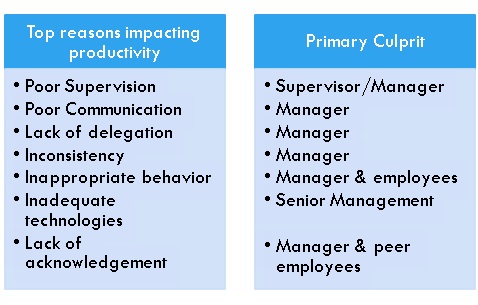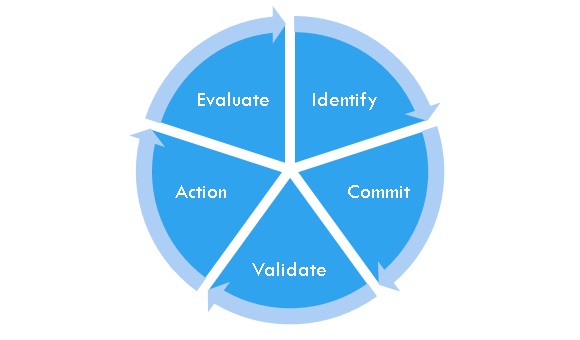 Research Paper By Anant Sharma
Research Paper By Anant Sharma
(Executive Coach, INDIA)
What is employee productivity and why is this important
For any organization, its employees are considered its assets as much as its product or service portfolio. Employees have the potential to both make or break the company they are working for. The company invests in its employees – this can be through salaries, incentives, perks like stock options, etc. What the company is expecting out of this is a positive return on its investment. The more productive employees are the more the company will get in terms of its return on investment. So employee productivity is directly related to the success of a company. And how do we define employee productivity?
Employee productivity, also called workplace or workforce productivity, is an assessment of an employee’s or a group of employees’ efficiency. It is evaluated by looking at the total workforce or employee output in a given time. In most cases, the productivity of an individual will be assessed in comparison to the average output of other employees doing similar work.
As the organization is into business, it will be financially prudent to hire (and retain) employees only if the employees produce value for the business exceeding the cost of employee wages. In this way, an employee is an investment, and the investment should provide a worthwhile return to the company. This can only happen if an employee is productive. Thus, the importance of productivity in an organization lies in the difference between an employee making the company profit and the employee costing the company money.
Let us also look at what are the other benefits of Employee Productivity for an organization. The below chart summarizes this

We now quickly look into these
As we can see, all these points are interrelated and there are multiple reasons why employee productivity is important – not only for the employees themselves but also for the organization.
In an ideal situation, this looks like a win-win situation both for the organization and the employees. However, in reality, the picture is not as rosy and there are multiple instances where employee productivity suffers. We will now examine the primary reasons which lead to reduced employee productivity

We will now look into each of these
Poor Supervision – Supervisors (or managers) are more to blame in case the productivity of a team is suffering. This can be due to the manager micromanaging, or not giving enough time for a task to be completed, or just playing favorites within the team. Adversely impacts productivity
Poor Communication – two-way communication with employees is the ideal situation to be in. Employees need to know what is coming up – a new announcement, direction, or policy. At the same time, it is equally important for the management to understand from the employees about their views. Not doing this adversely impacts productivity
Lack of delegation – If the manager has been an excellent performer during “his day”, there are chances he may not be good at delegation. Even otherwise many managers find delegating too difficult – they think they are giving away control to the team. This results in the team self-esteem taking a nosedive which in turn adversely impacts productivity
Inconsistency – A shifting goalpost can wreak havoc on the pace & quality of work. Clearly defined objectives with clearly defined milestones help employees plan and pace their work. Many times this is not the case and newer goals keep getting added in the middle of the earlier goals. This then distracts employees keeping them from putting in their 100% which in turn adversely impacts productivity
Inappropriate behavior – If employees or their supervisors indulge in acts such as sexual misconduct, bullying, showing up late for work then this too leads to a lot of distraction. More so, if the management is not able to take strict action against such things employees tend to lose focus which in turn adversely impacts productivity
Inadequate technologies – Technology is ever-changing and at a very fast pace. If the company is still stuck in old technology while customers have moved to the latest one, it becomes challenging to meet customer expectations. Failure to address this issue then leads to frustration in employees thereby impacting productivity
Lack of acknowledgment – If a high achiever is not acknowledged naturally he will feel bad. Peers not acknowledging (or even pulling down) is more prevalent but when the acknowledgment does not come from the manager, it really pinches. If this happens, productivity takes a beating
Let us now take a relook at these reasons affecting productivity and also add a column as to who is primarily responsible for each of these reasons
 As is abundantly clear, in a majority of cases it is the direct manager or supervisor whose behavior leads to a fall in employee productivity. There are areas here over which the manager has little control, as technology as that decision is taken at a much higher level. Barring this, in all cases, it is the manager who is our culprit in impacting productivity.
As is abundantly clear, in a majority of cases it is the direct manager or supervisor whose behavior leads to a fall in employee productivity. There are areas here over which the manager has little control, as technology as that decision is taken at a much higher level. Barring this, in all cases, it is the manager who is our culprit in impacting productivity.
This then leads us to the conclusion that if employee productivity is of importance to an organization, and with the reasons explained in the beginning there are no organizations who would not want this, it is the manager who needs to be looked into. How the manager behaves, carries himself in front of the team, communicates with the team, or in short how he manages has a direct bearing on employee productivity.
There are umpteen examples of good managers, excellent managers, and outstanding managers. However, there are also enough and more examples of mediocre managers. What then makes a manager a mediocre manager? After all, no one would like to be called mediocre, why then some managers turn out to be like this.
The reasons can be plenty. It really depends on what level the manager is – a junior manager or a senior manager. And at each of these levels, the challenges faced by managers are unique
Junior Managers
After the initial euphoria of becoming a manager, young achievers quickly realize that it is far easier doing things yourself than getting it done from your team. Here is when the young manager starts feeling disillusioned and need is felt for a certain new set of competencies hitherto unknown to young managers. Some of these are
Senior Managers
Challenges for senior managers are entirely different. In addition to the good things which every manager learns to like the art of managing teams, having tough conversations, etc. they have also learned how to categorize teams as favorites, neutrals, or non-favorites. How to judge team members basis this categorization. This in turn makes them biased and starts influencing their decision-making process which then makes further growth difficult.
Since the room at the top is limited, the higher the manager rises in the hierarchy the limited room he has for growth. As the challenges faced are different, so are the new competencies they need to develop. These are
Decisions taken by senior managers and leaders have a direct bearing on the direction of the organization as well as the careers of junior members in the organization. A leader also cannot afford to bear his feelings to colleagues since it is a fiercely competitive space. Moreover, as one grows, the number of friends you have in the office keeps on reducing which then leads to no “escape hatch” for pent-up feelings.
This is where the Coach steps in.
The Coach
The majority of the problem areas explained earlier can be addressed by the Coach. The Coach will engage with the managers (clients) and help in the identification of areas for discussion, create action plans, remove any past hurdles for the client to achieve his/her set objectives.
The Coach helps the client to remain focused on the goal as well as holding the client accountable for the steps and the process. The Coach also will from time to time challenge the client helping his/her forward movement.
The Coach sits with the leader to formulate an action plan to overcome the issues described above. Ideally, this is a 1-1 session with each manager since the situation for each is different and so are the set of challenges faced.
This process can be summarized as per the below figure
 The Coach will help the managers & leaders at each of these steps, namely
The Coach will help the managers & leaders at each of these steps, namely
Identify – It is said that the first step towards finding a solution to a problem is to identify the problem. More often the managers & leaders are so immersed in the day-to-day issues that problems glaringly visible to a neutral observer are missed out. The coach helps the client identify areas that demand attention
Commit – This is the logical next step where the leaders get down to committing their resolve to find a solution. While realization & identification of the problem is important unless there is a commitment to actually get down to resolving the problem it will remain unaddressed. This is also where the coach can challenge the client to make sure there is a commitment to addressing the problem
Validate – The plan of action thought of is put through a process of validation. This is done by the client using his experience to unearth if there can be any potential roadblocks to the process. Since we are talking about employees here, the roadblock would also include individual employee personalities & traits in addition to things like procedural delays, etc.
Action – Finally the plan gets into action mode with the manager/leader getting to implement with the employee. All that has been theorized till now is put into practice. As they say, this is where the rubber hits the road
Evaluate – No plan is a perfect plan and therefore this last step is equally important. It is at this stage any shortcomings in the plan are addressed and corrective action is taken. Based on the success of this plan, future templates can also be prepared by the leader in addressing similar challenges
Coaching Tools
The coach has several tools at his disposal however, in this situation the ones which will be of most use are the ones mentioned below
A. Active Listening – The clients here are leaders & managers who are used to one-way communication, which is from them to others. Active listening is extremely important as this will help the coach in understanding any limiting beliefs by “reading between the lines” for things that are communicated without being said
B. Presence – This is always in conjunction with active listening. More so when you have senior leaders as clients. Helps establish trust which then plays a big role in identifying challenges
C. Visualization – In this situation this tool can play an important role. The manager and his employees’ productivity is being discussed and visualization will quickly help them identify issues concerning growth, or things they are planning to do for a very long time but are unable to do
D. Enneagram, Wheel of Life & Strengths Finder – depending on the situation any one of these can be very helpful to create awareness for the client as well as give directions to the Coach on ways to take the client forward
E. Direct Communication – Who will bell the cat? This is an age-old saying and holds in the corporate world as well. Employees dare not give any opinion or suggestion on the working style of the leader. The coach can help the leader understand such situation better through direct communication
To summarize, Coaching is an important tool available to organizations to boost their employees’ productivity. Most organizations go through this phase and as described in this paper, a majority of the reasons can be attributed to the way the employees are led by their managers & leaders.
Coaching can help in a big way in identifying and addressing these problems.
Reference :
https://www.insperity.com/blog/8-reasons-why-employee-productivity-may-suffer/
https://kalyan-city.blogspot.com/2013/03/benefits-of-higher-productivity.html